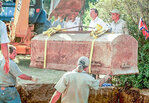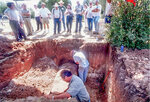

One of Hood County’s most fascinating, yet controversial, legends is that of notorious outlaw Jesse James.
The most popular theory is that James was killed in his Kearney, Missouri, home by a fellow outlaw in 1882. However, many speculate that James faked his death and came to Granbury, under the alias of J. Frank Dalton, where he lived until his death in 1951 at the age of 104.
According to the Granbury website, Dalton claimed he was the real Jesse Woodson James in 1948. He had applied for and received a Confederate pension from the state of Texas as John Dalton, born March 8, 1848. He later claimed to have been in every war since 1863, and that he was gassed while serving with the Canadian Army in World War I.
Many of James’ descendants believed that Dalton, who died in Granbury, was the real Jesse James, so a headstone was dedicated to the outlaw in the east end of the Granbury Cemetery.
2000 EXHUMATION
To put an end to the century-long legend, David Glassman, a forensic anthropologist at the time, was paid to dig up the body of the supposed Jesse James on May 30, 2000.
Glassman, who has served as president of Eastern Illinois University in Charleston, Illinois, for the past eight years, spoke to the Hood County News and detailed what took place during one of Granbury's most famous and televised events.
Glassman was contacted in February 2000 by former Texas Attorney General Waggoner Carr, who at that time, was representing a family member of James.
In 1995, the James family requested the exhumation of their ancestor's corpse from a Kearney, Missouri, cemetery, and DNA tests confirmed the remains were indeed those of the outlaw, according to an article on history.com.
One family member of James, however, didn’t believe that the findings were accurate.
“That family member did not believe that the excavation that took place in 1995 in Kearney, Missouri – where DNA was taken from some teeth – identified the individual as being the real Jesse James,” Glassman said. “He did not believe that the DNA was accurate and that it may have been either contaminated or some other issue, because this family member did indeed believe that his great-great-grandfather had actually died in 1951 and is buried at the Granbury Cemetery.”
Glassman – who handled approximately 350 human identifications in his career – was asked to exhume the body and obtain DNA samples to prove whether or not the body in the plot was that of the real Jesse James.
"I indicated to Mr. Carr that I would not go out there and do that unless there was a court order that would be essentially allowing permission for the body to be exhumed for that purpose,” he said. “I also said, ‘Do you really want to exhume the body because this is a landmark tourist element of Granbury; and if I was to exhume the body and it wasn't Jesse James, then that would end that historical element that Granbury has taken pride in for so many years?’ But they said, 'No, we are sure that this is the real Jesse James. We're going to demonstrate it.’ So, they did take it to court, and the judge of the court allowed for the body to be exhumed."
On May 30, 2000, approximately 75 individuals attended the exhumation at the Granbury Cemetery. According to the June 3, 2000, article in the Hood County News, the exhumation made television, radio and newspaper accounts across the nation. The newspaper alone fielded calls from as far away as London and Canada. Even the Comedy Channel on cable television did a spoof of the exhumation on one of its shows.
“There were a lot of people there during the day,” Glassman said. “It was, for some, like a celebration. A lot of people were curious. There was certainly law enforcement there and people trying to control the public. It was a pretty big spectacle.”
SURPRISING FIND
Glassman began digging in front of the tombstone and eventually excavated the metal casket, which was then put into a hearse and transported to a city garage, where the examination of the body would then begin.
"One of the first things that I do when I do an examination of an individual is I take an inventory of everything that's there," he said. “Sometimes bones will erode, and you won't have anything present from them. As I was doing that inventory, there was not an ‘aha’ moment, if you will, but there was something like that.
"After I started the skull and started working my way down the body, I noticed it was covered with some fragments and so, when I got to the arms, there was one arm that was amputated, and it would have been amputated long before the person died. The bone there was atrophied. So immediately I asked the family members if Jesse James was an amputee and they said, ‘Absolutely not,’ and I said, ‘Well, then we can stop here because this is not Jesse James – nor is it J. Frank Dalton, because J. Frank Dalton had both arms at the time of death. So, here I've got an unknown body in the cemetery plot of J. Frank Dalton, also known as Jesse James. Now the question is: Who is the body that we dug up?”
Glassman said the body that was exhumed was eventually identified as Henry Holland, an amputee who had passed away in 1927.
SEVERAL QUESTIONS
Glassman said it was thought at the time that Dalton was buried in a wooden casket, not a metal one. When the excavation was taking place, he said a few pieces of rotten wood were found one plot over from what is now known as Holland’s grave – leading people to believe that James/Dalton was actually buried in the plot adjacent to Holland’s.
"After I told them that this is not Jesse James, then everybody was asking me to go back and excavate next to it where we found some wood chips," Glassman said. “I told them that I was unwilling to do that, because the court order only indicated the exhumation of one body, and that was the body laid at the plot with the Jesse James monument at it.”
Glassman said since the adjacent plot was never exhumed, some believe that the monument was placed over the wrong grave, or the ground shifted and forced the monument to move in front of Holland’s plot instead.
"The mystery still exists, because we were not able to prove one way or the other that the remains of J. Frank Dalton were or were not Jesse Woodson James,” he said. “Nobody has DNA, that body has never been recovered, and it's still presumably, in the Granbury Cemetery.”
RUMORS SURFACE
Glassman said that several individuals believed that he was brought in to conduct the exhumation with an agenda to disprove the legend, but he said that was farthest from the truth.
"As a scientist, I'm totally unbiased,” he said. “To me, I do this as a science, and the outcome is based on the science that's found. I have no opinion one way or the other. Some people thought I was on a team to help prove that the Missouri exhumation was correct. No, I was essentially hired to exhume a body and extract elements for DNA analysis to see if that was Jesse James.”
MYSTERY CONTINUES
More than 20 years have passed since the exhumation was done on James’ reputed grave – but whether or not the notorious outlaw is buried in Granbury or Missouri continues to remain a mystery to this day.
“The mystery still continues and probably should remain a mystery,” Glassman added. “This is part of the lore. It's part of the Granbury story, and I would suggest that it be left at that.”
He added that it’s not uncommon for elderly individuals to have misrecollections of their lives, which could have led J. Frank Dalton to assume the identity of Jesse James.
"Dalton may have had an affiliation with Jesse James, if he was not Jesse James himself; and in an elder age, just kind of morphed in his mind that he was Jesse James, even though he may have been an affiliate of Jesse,” Glassman explained.
Whatever the case may be, however, perhaps it’s best to let this certain mystery remain unsolved.
Glassman added, "It's an interesting story – and one that is destined to be continued.”